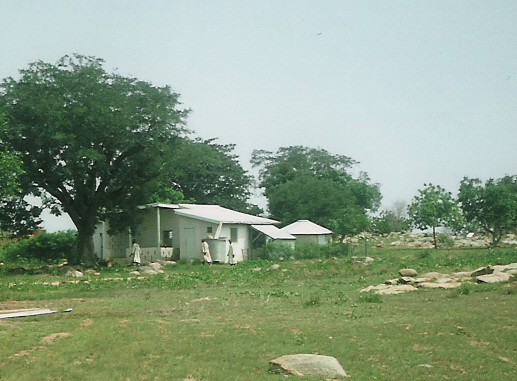Early History of the Presbyterian Mission of Sandema
Many Europeans imagine that the members of traditional religions are inclined to reject all kinds
of Christian missionary work in their villages and expect their chief to prevent the establishment
of mission stations. When, in 1927, catholic missionaries were looking for a suitable place for
their mission house, the Sandemnaab was quite willing to offer a convenient site for their houses
and church. In fact, he was even resentful, when they chose Wiaga as the more central Bulsa
village for their starting point.
In 1956, the Presbyterian Church sent its first missionaries from the then Gold Coast to the
Bulsa area for an initial inspection regarding the possibilities for a future mission station. The
Paramount Chief Azantinlow was pleased to give them a site north of the market centre in the Kobdem section.
It was Rev. Colin Paton and
a groups of missionaries who had toured the North to find an appropriate place
for a new station. The reasons for choosing Sandema can be found in their report
(Berinyuu, p. 108-109):
We are agreed in recommending Sandema as the place where a missionary should be
stationed to open Presbyterian Mission work in the Builsa country. It is the seat of the
Paramount Chief, the District Council and has the only Middle School in the area, the
densest population is in the area round it, it has an all season road to it... The main
Roman Catholic centre is not at Sandema but at Wiaga, 6 miles away, where there are at
least two priests stationed. There is however a Roman Catholic “catechist” at Sandema,
and a small Roman Catholic chapel.
While the Catholics had started to establish first contacts with the local people by means of
schools, Paton wanted to concentrate on mission work in the compounds. He built the first
mission house in Kobdem, doing language studies, translating parts of the bible to provide Buli
texts for the Divine Service, offering night school classes to young Bulsa and starting contacts
with the people of Chuchuliga. Relations with the Roman Catholic Mission seemed to be better
than expected. Paton writes in his report (p. 120):
After our arrival in Sandema, I waited till the Duncans had arrived before calling on the
White Fathers at Wiaga, but before we had done that, they had called on us in our
absence, and had also very kindly written offering any help we needed when they heard
that our temporary kitchen of grass mats had gone up in flames. When we did visit
Wiaga, we had a very friendly welcome from Fr Lemaire, who said that while they
obviously regretted our coming into the area, he saw no reason why we should scrap like
cats and dogs.
In March 1957, Rev. Robert Duncan, like Colin Paton a Scotsman, arrived in Sandema together
with his wife Louise, a qualified nurse. They successfully continued the work of the Patons, not
only in Sandema, but also in Chuchuliga-Namonsa, where they were able to establish an
outstation under the supervision of Johnson Akobrika, a catechist from the Sandemnaab’s
family. The Presbyterian mission work even crossed the tribal boundaries when they extended
it to Chana and Katiu, north of Sandema in the Kasena area. Louise Duncan established a
mother and baby clinic in Sandema, which soon developed into a general medical clinic.
 Rev. Alan Byers, who took charge of the Presbyterian Parish in February 1960, managed to
acquire a suitable site for a stone chapel in Sandema. It was dedicated in July 1963. The clinic
was extended and the donation of a landrover made it possible it transport sick people.
Rev. Alan Byers, who took charge of the Presbyterian Parish in February 1960, managed to
acquire a suitable site for a stone chapel in Sandema. It was dedicated in July 1963. The clinic
was extended and the donation of a landrover made it possible it transport sick people.
A small episode, remarked in passing, might be worth mentioning. When pastor Byers was
returning from a leave in Britain (1966), he met a young anthropologist from the German
University of Münster on board his ship. It was Prof. Rüdiger Schott, who was on his way to do
his first extended field research in Northern Ghana. He was, however, not yet quite sure, where
to start. Pastor Byers invited him to come to Sandema and live in the Presbyterian Mission. The
decision to do research among the Bulsa was the beginning of half-a-century successful
anthropological research by the University of Münster in this area (Cf. also Buluk 3, p. ).
After Pastor Byers, Rev. James Agalic, the first Presbyterian Bulsa pastor, took charge of the
parish. Today, the mission station has become a large enterprise with a flourishing agricultural
station, an efficient clinic, office buildings and all the other institutions started by the early
missionaries.
 Rev. Alan Byers, who took charge of the Presbyterian Parish in February 1960, managed to
acquire a suitable site for a stone chapel in Sandema. It was dedicated in July 1963. The clinic
was extended and the donation of a landrover made it possible it transport sick people.
Rev. Alan Byers, who took charge of the Presbyterian Parish in February 1960, managed to
acquire a suitable site for a stone chapel in Sandema. It was dedicated in July 1963. The clinic
was extended and the donation of a landrover made it possible it transport sick people.